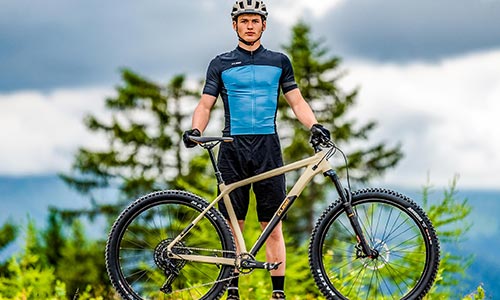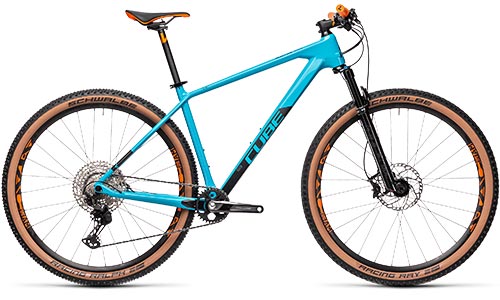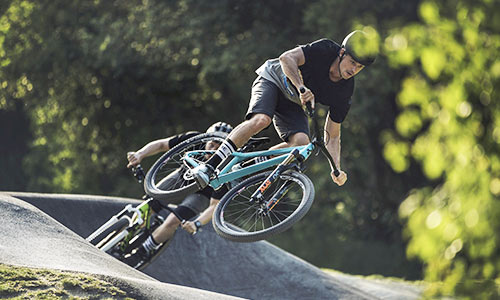
MOUNTAINBIKE – Hardtail
Can you already see yourself... on your new hardtail? How you jump off the curb and onto the street, skid over leaves, crash your tires into a gravel bed, kick up dust clouds and cut through deep puddles – and another time in your jacket, with your tires humming, you speed through the city to work while your suit merely camouflages what you really are... Stylish, sometimes rebellious, daring, yet confident. If you're grinning broadly, you've come to the right place. Let's be honest, we've all had enough of being confined, and even more so the longer the coronavirus restrictions keep nagging us. Where can we channel our energy if not into movement?
Filter products
Nothing comes closer to flying than a wild ride on your bike, to the places you really want to be. Just diving down somewhere in the here and now, maybe all alone. Just forgetting about time and breathing, sometimes a little harder. Who knows what it feels like to let the day pass in review in the evening, when it is saturated with adventure, the breaking down of your own limits and a fading dose of adrenaline? Who, if not us, the passionate bikers? We are characterized by the courage to do everything a little differently, to finally take the plunge. After all, MTB also stands for motivation, temperament and grit. Crossing these boundaries can mean something completely different for everyone: sometimes it just means getting up and sweating, but for you it could go much further..
The most important thing for you to consider in advance is which trails you prefer, because this determines whether a hardtail or a fully is better suited for you. With a hardtail, the rear part remains stiff, i.e. hard. With it, you do without a rear shock absorber; a sprung front wheel is enough for you. In addition to titanium and steel, carbon and aluminum are preferred materials. Your hardtail should therefore weigh very little, with a maximum of 13 kg. Long day trips are not a problem, and maintenance is also less.
You can vary the wheel sizes and thus better adapt your bike to your needs. With larger wheels (29 inches), your pedaling energy is converted more optimally. You should also prefer slightly wider tires if you like to ride over stones and roots, because this will give you better traction and smoother running. Disadvantages include the higher weight and more effort uphill, as well as slightly reduced maneuverability.

The 27.5-inch version
If, on the other hand , you choose the 27.5-inch version, you can look forward to more maneuverability and less weight, and you may also find the look more appealing. On the other hand, there are poorer rolling characteristics and reduced traction. Overall, the only real disadvantage is a minimal loss of speed. The stiffness of a hardtail ensures better road holding if you mainly use paved roads and only occasionally go cross-country. At the same time, you can save a few euros, since the additional rear suspension on a fully-suspension bike costs quite a bit. Expect a difference of about 800 euros. You can get a good hardtail for as little as €1,200. A comparable fully should only be purchased for €2,000 or more. At first glance, additional suspension may seem more advantageous, but this is deceptive, because in your individual case, power transmission and braking performance are the decisive criteria.
Classic
The hardtail is the original design. The era of the MTB was ushered in in California in 1973, and since then these popular bikes have continued to develop, are constantly being ergonomically improved and can be adapted to individual needs. With fewer moving parts, a hardtail is less prone to wear and tear than a fully. Generally speaking, the pros and cons of these two MTB specifications balance each other out. And if your wallet has a say in the matter, you'd be better off with a top-notch hardtail than with a barely acceptable, so-so full-suspension bike. As already mentioned, excellent, long-lasting full-suspension bikes are considerably more expensive.
If you are still unsure, then listen to yourself. You can surely guess what the next few months will bring – and what you have already proven to yourself in the past. You know yourself. If you are still hesitating, think about how you want to shape your future everyday life... Do you want more, but not too much? Does the idea of "safe wildness" appeal to you more than the term "adrenaline kick", and do you want to use your bike mainly on paved and asphalted roads? Do you see yourself more as a sensible and considerate rebel who likes to stay in control? Then a hardtail is definitely the perfect choice for you. Don't forget: your bike should suit you, it should fulfill what you want. So this is not about better or worse bikes, but about customized "pleasure supporters"!

Wheel size comparison – should it be a 26", 27.5" or a 29" MTB?
| Criterion | 26 inch | 27.5 inch | 29 inch |
|---|---|---|---|
| Smooth running | ★★ | ★★★★ | ★★★★★ |
| Stiffness | ★★★★ | ★★★★★ | ★★★★ |
| Rollover behavior | ★★ | ★★★★ | ★★★★★ |
| Weight | ★★★★★ | ★★★★★ | ★★★ |
| Acceleration | ★★★★ | ★★★★ | ★★★ |
| Agility | ★★★★ | ★★★★ | ★★★ |
Suspension
Thanks to the suspension fork/telescopic fork on the front wheel, shocks are absorbed, while the frame's rigidity ensures a more precise riding technique. This stability promises you noticeably more safety. A fully should only be considered if your requirements demand it due to technically difficult routes and your preferred terrain variability. In general, a hardtail gives you more options in terms of route choice in less demanding areas.
Overview/comparison
The advantages and disadvantages of hardtails compared to full-suspension bikes are easy to summarize:
- Enjoy the weight, price and low maintenance of your hardtail.
- Look past the slightly less leeway, the lower traction and a minimal loss of speed.
CROSS COUNTRY or RACE-BIKE
These are preferred for cyclists who focus on performance in short races up to 50 kilometers and fast tours. Over rough and smooth terrain, on tours full of demanding sections, less fast-paced but more precise. With this bike, you primarily want to be prepared for anything, despite time pressure and changing trails. Thanks to the balanced properties of these bikes, you are sure to achieve your goals. The specifications of marathon bikes are modified to be prepared for long tours and marathon races. Expect less comfort, but your energy will be perfectly converted, and the weight of these bikes is kept as low as possible. In numbers, this means: a maximum of 13 kilograms, but better under 10 kilograms. These bikes can handle unpaved terrain, but you should avoid technically very demanding trails. The trekking variants are similar, although they are a step further away from difficult terrain – perfect for you if you are a bit more oriented towards riding on paved roads.
DIRT JUMP
As the name suggests, this variant primarily concerns the cycling variant of jumping with a bike in order to perform various so-called "tricks" in the air. Meanwhile, the boundaries between the hardtail and fully variants are beginning to blur. We have therefore only listed the usual classifications here, as there have been hardly any significant developments in the transition area so far.
You can reach us by phone (+49 (0)791 - 95 66 89 50), by email [email protected] or by using the contact form.
























